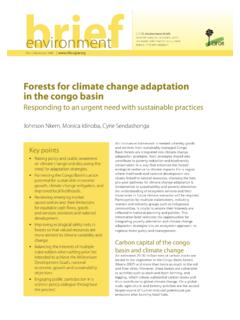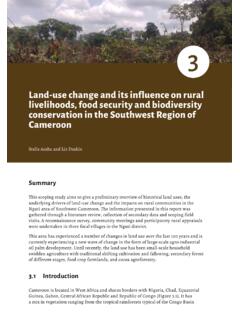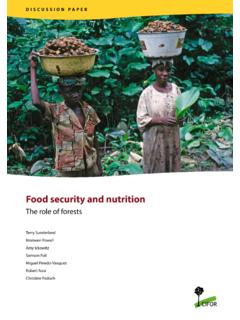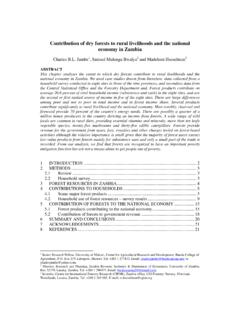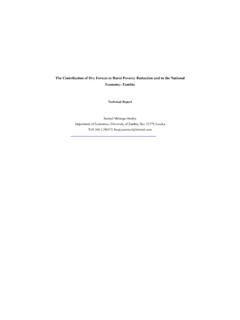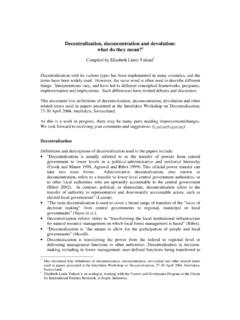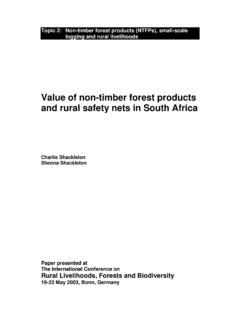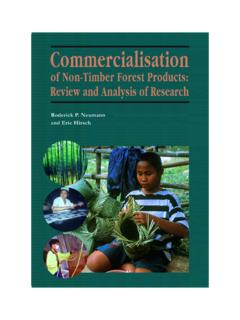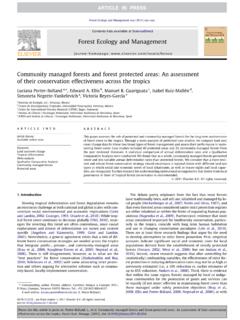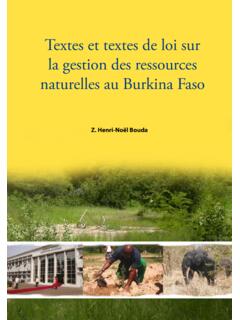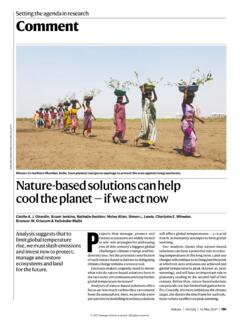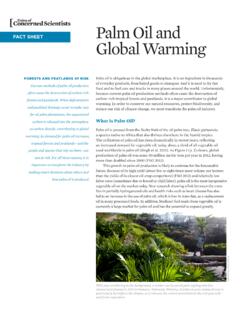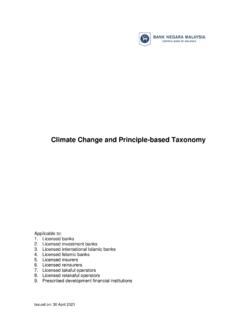Transcription of The local impacts of oil palm expansion in Malaysia
1 WORKING PAPER. The local impacts of oil palm expansion in Malaysia An assessment based on a case study in Sabah State Awang Ali Bema Dayang Norwana Rejani Kunjappan Melissa Chin George Schoneveld Lesley Potter Rubeta Andriani Working Paper 78. The local impacts of oil palm expansion in Malaysia An assessment based on a case study in Sabah State Awang Ali Bema Dayang Norwana World Wide Fund for Nature (WWF- Malaysia ). Rejani Kunjappan World Wide Fund for Nature (WWF- Malaysia ). Melissa Chin World Wide Fund for Nature (WWF- Malaysia ). George Schoneveld University Utrecht Lesley Potter Australian National University (ANU).
2 Rubeta Andriani Center for International Forestry Research (CIFOR). Working Paper 78. 2011 Center for International Forestry Research All rights reserved Dayang Norwana, , Kunjappan, R., Chin, M., Schoneveld, G., Potter, L. and Andriani, R. 2011 The local impacts of oil palm expansion in Malaysia : An assessment based on a case study in Sabah State. Working Paper 78. CIFOR, Bogor, Indonesia. Cover photo by Craig Morey Palm oil fruit harvest, Malaysia This report has been produced with the financial assistance of the European Union, under a project entitled, Bioenergy, sustainability and trade-offs: Can we avoid deforestation while promoting bioenergy?
3 ' The objective of the project is to contribute to sustainable bioenergy development that benefits local people in developing countries, minimises negative impacts on local environments and rural livelihoods, and contributes to global climate change mitigation. The project aims to achieve this by producing and communicating policy relevant analyses that can inform government, corporate and civil society decision-making related to bioenergy development and its effects on forests and livelihoods. The project is managed by CIFOR and implemented in collaboration with the Council on Scientific and Industrial Research (South Africa), Joanneum Research (Austria), the Universidad Nacional Aut noma de M xico and the Stockholm Environment Institute.
4 The views expressed herein can in no way be taken to reflect the official opinion of the European Union. CIFOR. Jl. CIFOR, Situ Gede Bogor Barat 16115. Indonesia T +62 (251) 8622-622. F +62 (251) 8622-100. E Any views expressed in this publication are those of the authors. They do not necessarily represent the views of CIFOR, the authors' institutions or the financial sponsors of this publication. Table of contents 1 Introduction 1. 2 Social and environmental impacts of oil palm plantations in Malaysia 1. 3 Background to the case study 3. 4 Methodology 6. 5 Findings 7. Environmental impacts 7. Socio-economic impacts 8.
5 6 Discussion 14. 7 Conclusion 14. 8 References 15. List of tables and figures Tables 1 Land cover change (in hectares) 8. 2 Perceived environmental impacts of oil palm plantations among local stakeholders 9. 3 Reasons for perceived livelihood impacts among employees 11. 4 Types of income stream among independent growers 11. 5 Most common factors impacting on livelihoods of respondent affected neighbours 13. Figures 1 Land use map of the study area and its surroundings in 2007 4. 2 Map of the study site at PPB OP Berhad 5. 3 Land cover analysis using Landsat prior to oil palm plantation development (a), near the mid-point (b), and in the most recently available image (c) 7.
6 1. Introduction is attributable to the country's large timber industry and the growing oil palm plantation sector. An This study is part of a broader research process analysis by Koh and Wilcove (2008) suggests that assessing the local economic, social and during the period 1990 2005, close to 60% of the environmental impacts from feedstock expansion oil palm expansion in Malaysia was at the expense for the growing biofuel sector (see German et al. of forest conversion, with the remainder coming 2011). Nonetheless, in the Malaysian context, from existing cropland ( , rubber, cacao). Toh biofuel production volumes are negligible despite and Grace (2006) argue that the substantial loss of government interest in promoting sector expansion .
7 Forests in Sabah was due primarily to over-harvesting, Since Malaysia is the second largest palm oil poor logging practices, short logging cycles and producer in the world, palm oil is slated to become the absence of rehabilitation following harvesting. the primary feedstock for biofuel production in the These activities resulted in a massive reduction of country. Since palm oil consistently outperforms primary forest cover between 1975 and 1995, from all other substitute vegetable oils on price, it is also million ha to 300 000 ha, and a corresponding becoming an important feedstock globally. While a increase in degraded forest , which reached rapidly growing global biofuel sector could develop million ha (Mannan and Yahya 1997, cited in into an important new market outlet for Malaysia , Toh and Grace 2006).
8 It does carry a number of risks. This paper aims to reflect on these risks by exploring the local social Sabah then transitioned towards the development and land-use impacts of oil palm in the Beluran of a cash-crop estate economy, in which powerful District of Sabah State. This is based on household state associations (Yayasan Sabah) were granted surveys to discover the perception of impacts among powers to allocate the land and control the trade in relevant local stakeholder groups, and remote-sensing key products such as timber and palm oil. Forests analysis. While the impacts of oil palm in the study on state lands not identified as forest reserves were site cannot be attributed to the biodiesel industry unprotected.
9 The state had the right to alienate1. per se, lessons learnt will be directly applicable to such lands for development; and they were usually the biodiesel sector in Malaysia , and relevant for the logged and cleared for agriculture (Toh and Grace whole Southeast Asia region. 2006). In the 1980s, huge areas of degraded forests in Sabah were degazetted and cleared for oil palm The following section offers a general survey of the cultivation (Jomo et al. 2004). From 1973 to 1992, social and environmental impacts associated with Sabah's forest cover outside protected areas declined oil palm development, with emphasis on the state of from 51% to 15% (Tanner and Kirk 2008).
10 By 2003, Sabah. This is followed by a brief overview of the case some 87% of the total land cultivated in Sabah was study site and the research methodology adopted for under oil palm (Toh and Grace 2006). By the end of data collection. The next section presents findings the first decade of the 2000s, oil palm covered about from the field research. The paper concludes with a million ha in Sabah (Wahid 2010). The state is reflection on the findings and implications for the the biggest palm oil producer in Malaysia , accounting governance of oil palm development n Malaysia . for approximately 31% of the total national output (POIC 2010).
